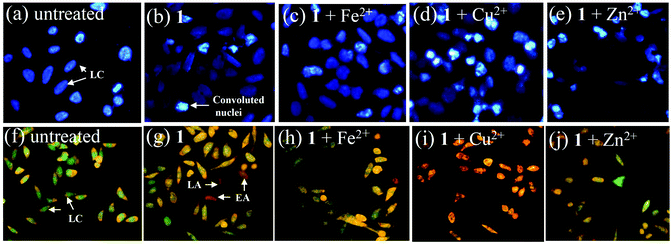 Open Access Article
Open Access ArticleCreative Commons Attribution 3.0 Unported Licence
Correction: Impact of metal binding on the antitumor activity and cellular imaging of a metal chelator cationic imidazopyridine derivative
Mithun
Roy
a,
Balabhadrapatruni V. S. K.
Chakravarthi
b,
Chelliah
Jayabaskaran
b,
Anjali A.
Karande
*b and
Akhil R.
Chakravarty
 *a
*a
aDepartment of Inorganic and Physical Chemistry, Indian Institute of Science, Bangalore 560 012, India. E-mail: arc@iisc.ac.in
bDepartment of Biochemistry, Indian Institute of Science, Bangalore 560 012, India. E-mail: anjali@iisc.ac.in
First published on 11th October 2019
Abstract
Correction for ‘Impact of metal binding on the antitumor activity and cellular imaging of a metal chelator cationic imidazopyridine derivative’ by Mithun Roy et al., Dalton Trans., 2011, 40, 4855–4864.
During the course of revising the manuscript, the authors inadvertently selected an incorrect image for Fig. 9c (1 + Fe2+). This image was mistakenly duplicated from Fig. 9e during preparation of the figures. The correction to the image in Fig. 9c does not affect the conclusions of the paper. The corrected Fig. 9 is shown here.
The text, the figure legends, and the conclusions of this article are not affected by this correction. The authors apologize for any inconvenience that these errors in final figure revision/preparation may have caused.
The Royal Society of Chemistry apologises for these errors and any consequent inconvenience to authors and readers.
| This journal is © The Royal Society of Chemistry 2019 |

